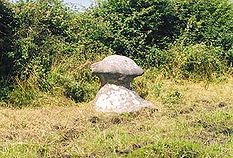- Mushroom stones
-
 The Stone Mushrooms near Beli Plast Village in Bulgaria
The Stone Mushrooms near Beli Plast Village in Bulgaria
Mushroom stones, or wave stones, are limestone boulders undercut by water. These take the form of solitary sentinels of limestone which still bear the unmistakable marks of long-continued erosion by lapping waves at the edge of lakes which have since vanished or retreated. These stone sentinels are sometimes shaped like mushrooms; others have an overhang facing in just one direction, but all are notched and undercut in such a fashion as to suggest prolonged exposure to standing water at some time in the past. The mushroom-shaped stones are produced where the notching forms a fairly even circle around the stone. The wavestones in Ireland are always of limestone: generally isolated boulders which are often glacial erratics, or (much more rarely) exposed outcrop. In Ireland, wave stones were first recorded in 1865 by F.J. Foot along the shores of Lough Ree, during the course of field work for the first systematic geological survey of Ireland. He made a drawing of these water-worn limestone blocks ‘eroded up to a certain height by the solvent action of former lake water, showing the level at which Lough Ree once stood – 10 to 15 feet higher than the present summer height: the lake shore, moreover, is now some 300 yards distant.’
Not all mushroom stones are situated close to modern lakes. Many mark the shores of lakes which have vanished altogether, becoming filled in with reedswamp, fen and bog vegetation in the course of time. A remarkable example is located near Crancreagh Bridge in County Offaly, which marks the position of what must have been the north-western edge of ancient Lough Boora, on whose shores the first people of the Irish midlands camped in Mesolithic times 8,500 or so years ago. This ancient lake disappeared long ago, swamped by the growing expanse of bog, which buried not only the lake itself, but preserved the campsites of the early midlanders.
To date, wavestones have been recorded in Counties Offaly, Tipperary, Galway, Clare, Cork, Roscommon and Westmeath.
Limestone accounts for nearly half of the framework of which the land of Ireland is made. Where it breaks through the envelope of soil and other materials which usually cover the rock beneath, it forms some of the most dramatic landscapes in the country. There are very few parts of Ireland where limestone so dominates the landscape as in the baronies of Burren in Clare and Kiltartan in Galway. Here the grey limestone attains a thickness of 780 metres, exposed over an area of more than 250 square kilometres.The story of the limestone begins about 350 million years ago, at the very end of the Devonian period of earth history, when Ireland was still part of the Old Red Sandstone continent. At around this time the sea - which up to this had lain to the south - began to advance northwards over Ireland, ushering in the Lower Carboniferous period of earth history. A thick sequence of lime-rich (carbonate) sediments was deposited in the warm, shallow sea as the millennia passed. This thick blanket of sediment was later compacted and hardened to become limestone rock.
Where a limestone boulder stands at the edge of a lake so that it is partly covered by water, the underwater part weathers more rapidly then the part above water because it is subject to more constant corrosion by water, accentuated by the abrasive lapping action of waves. If this continues for a long time the upper part will be undercut, and the stone will assume a very distinctive form which is frequently mushroom-like. Much more rarely the same process can be seen in limestone bedrock. Many mushroom stones have a second minor ‘lip’ below the main one, suggesting that the drop in water level which isolated the stones from the lake’s edge took place in two stages.
See also
External links
Categories:
Wikimedia Foundation. 2010.

